- Author Matthew Elmers [email protected].
- Public 2023-12-16 21:49.
- Last modified 2025-01-24 09:17.
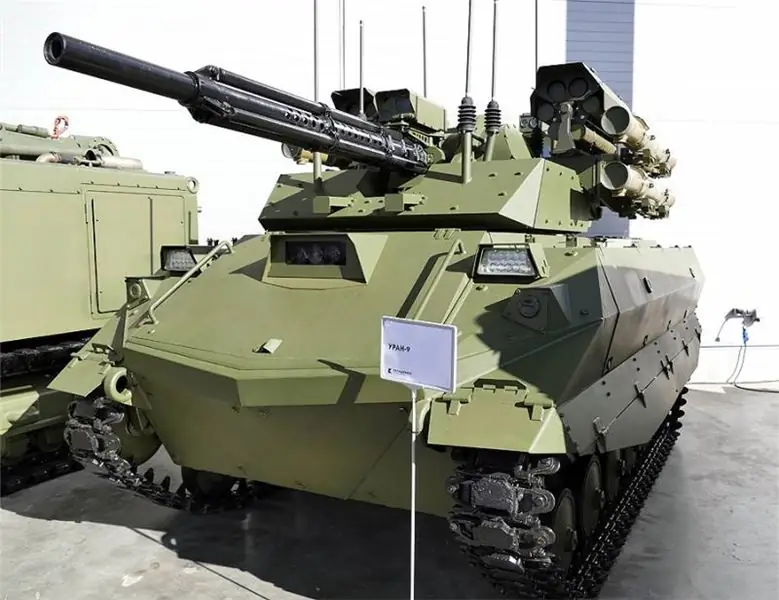
The experience of operating remotely controlled vehicles (RMS) influenced the change of some priorities aimed at reducing the logistical load and increasing the flexibility of use. The military is currently looking for systems that can use a common universal controller, have a single chassis configuration that can accommodate different target loads, that is, platforms with an increased level of modularity.
The choice of RMS on the market is extremely diverse, ranging from nanomachines to heavy multi-ton systems. In the same article, the latter will be considered, especially those equipped with one or another weapon system. Armed robots are the subject of fierce debate over ethical, legal issues, etc., although some countries have already begun deploying them, mainly to assess and develop a concept for combat use. For example, in May 2018, the Deputy Minister of Defense confirmed that the armed DUM Uran-9, developed by the 766 Production and Technological Completion Directorate, had been deployed in Syria for testing. It follows from the report of the Ministry of Defense that these combat tests of the complex revealed shortcomings in its control, mobility, firepower, reconnaissance and observation functions.
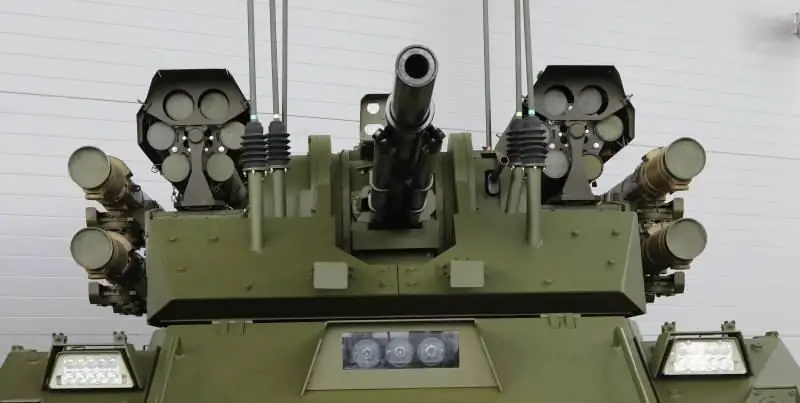
Uranium-9 from Russia
Combat multifunctional robotic complex Uran-9 is armed with 30-mm automatic cannon 2A72, paired with it 9, 62-mm machine gun PKT / PTKM and four ATGM 9M120-1 "Attack". As an option, the Igla anti-aircraft complex or the Kornet-M ATGM can be installed on Uran-9. At the Army 2018 exhibition, this robot was presented in an updated version, equipped with two six-barreled Shmel-M launchers for firing Shmel-PRO missiles with thermobaric (PRO-A) or incendiary (PRO-3) warheads. The Uranus-9 robot is able to move off-road at a speed of 10 km / h, the maximum speed is 25 km / h, it can be controlled by radio channel from a mobile control center located less than three kilometers away. This machine has quite impressive dimensions: length 5, 1 meters, width 2, 53 meters, height 2, 5 meters and a mass of about 10 tons, which is explained by the installation of basic armor, which provides protection against small arms fire. In turn, the Concern "Kalashnikov" has developed an automated combat system BAS-01G BM "Companion", whose armament complex can include 12, 7-mm and 7, 62-mm machine gun, 30-mm AG-17A grenade launcher and a new 40-mm automatic grenade launcher. The UAS also provides for the installation of eight Kornet-EM anti-tank missiles.

THeMIS from Estonia
In the field of armed robots, it should be noted a platform that has been used by numerous companies to develop unmanned armed systems. This is the THeMIS platform developed and manufactured by the Estonian company Milrem Robotics. THeMIS stands for Tracked Hybrid Modular Infantry System. This open-architecture platform weighs 1,450 kg and is powered by a diesel engine and an electric generator; in hybrid mode, it can run for 8-10 hours, while in all-electric mode, the operating time ranges from 0.5 to 1.5 hours. In a typical configuration, one of the modules contains batteries and another generator, meaning customers can choose between an all-electric and a hybrid solution. Milrem has evaluated various types of batteries and is ready to install fuel cells upon customer request. THeMIS can reach a speed of 14 km / h and overcome slopes up to 60% and side slopes up to 30%. The device has a length of 2.4 meters, a width of 2, 15 meters and a height of 1, 1 meters, the dimensions of the platform for the target load between the two side modules is 2.05x1.03 meters, it can take 750 kg of load.
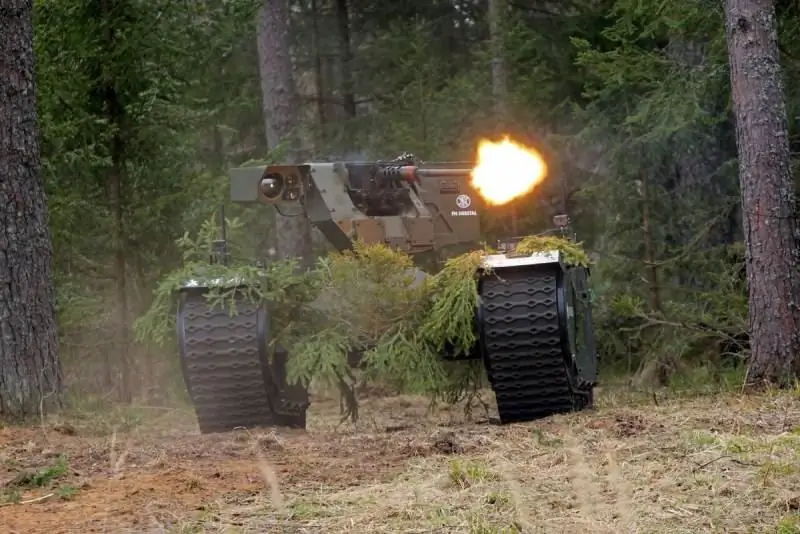
When used as a transport system, the THeMIS cargo area is equipped with a 53 cm high cage with an internal volume of 1.12 m3. Milrem devices are complemented by various remote control options and autonomous capabilities. Among them are waypoint navigation, area navigation used to neutralize improvised explosive devices and search and rescue missions, follow the leader, driver assistance and sentry modes. In order to optimize the path of the DUM, intelligent route planning is also available with functions for checking the sectors of view, radio range and terrain type.
Also, for this robot, more advanced modes are being considered, for example, improved detection and avoidance of obstacles due to learning neural networks in a virtual learning environment, commands with voice and hands in order to reduce the load on the operator in the field and augmented reality, which allows the operator to fully immerse, which finds himself in the center of the action with all the necessary projected information. “Autonomous capabilities today are not at the level that would allow us to solve all possible scenarios that our SMB may face, so our autonomous kit is always tailored to the needs of customers, said Mart Noorma from Milrem Robotics, explaining that it is difficult to evaluate the current status of various developments based on the overall level of technological readiness, as a perfect solution for one scenario may be quite useless for another. Milrem Robotics is able to design customer-specific solutions that include components from the capabilities and technologies listed above.
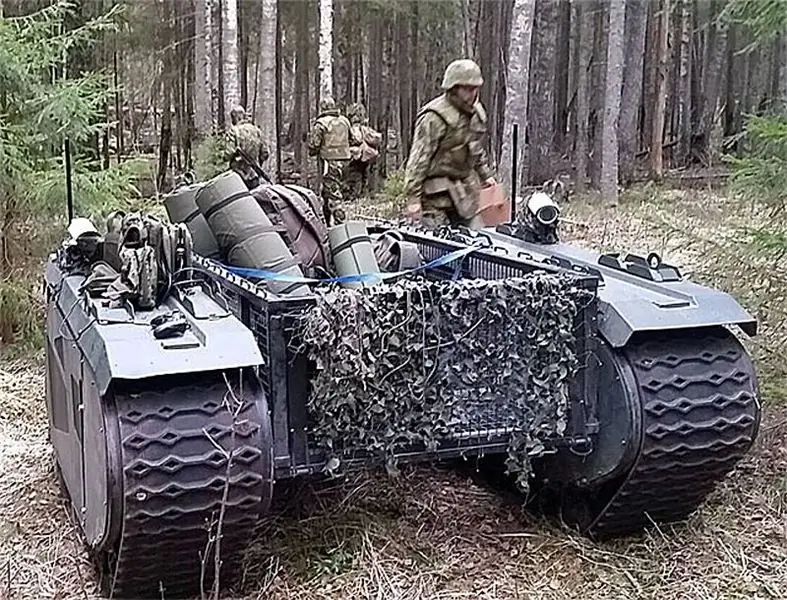
The Estonian company provides customers with another useful tool called DIBS (Digital Infantry Battlefield Solution). “It was developed in collaboration with military experts to demonstrate the potential of ground mobile robots in combat operations, both as individual platforms and as part of a group, as well as when humans and robots work together,” added Noorma. DIBS works as a kind of combat laboratory, which allows you to understand how to deploy DUMs in order to optimally use the fleet of such devices, as well as to practice the task.
The Estonian company provided its platform to several partners who installed their systems on it. Singapore Technologies Engineering signed an agreement in 2016 to use THeMIS as the basis for several possible products and installed its Adder Remotely Operated Weapon Module (DUMV), armed with a 12.7mm machine gun or 40mm automatic grenade launcher. At IDEX 2017, Milrem and IGG Aselsan presented THeMIS, equipped with a DUMV SARP developed by Turkish Aselsan. while a month later the Estonian company announced a collaboration with Kongsberg and QinetiQ North America to install a Protector module on the DUM, in which case QNA will provide the control system.
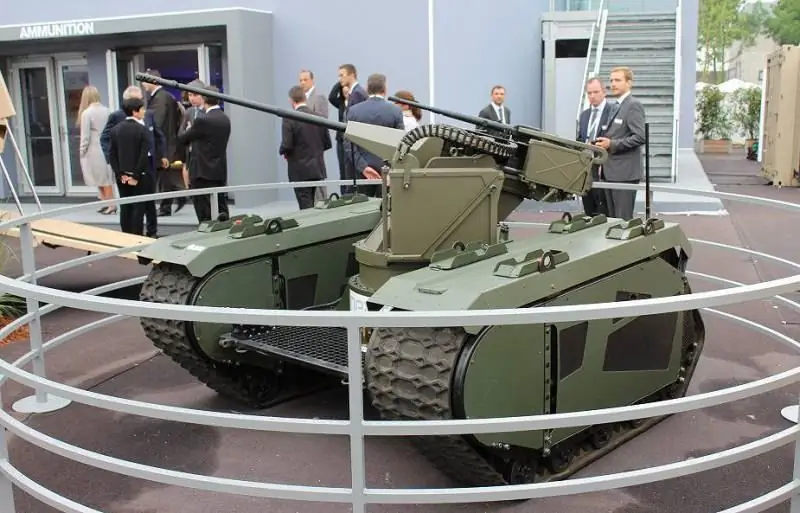
Heavy weapons for THeMIS
At Eurosatory 2018, Nexter showed off the ORTIO-X20, a combination of the THeMIS robot with its ARX-20 remotely controlled weapon module with a 20mm cannon. This was the first attempt to mount a medium-caliber weapon on this DUM. ARX-20 is armed with a 20M621 cannon for a 20x102 mm projectile and an optional coaxial 7.62mm FN MAG 58 machine gun. At the same exhibition, one could see THeMIS with an FN Herstal deFNder Medium module, armed with a 12.7mm M3R machine gun. At the exhibition, Milrem Robotics and MBDA announced an agreement to develop a variant of the DUM armed with the fifth generation of the MMP anti-tank missiles. They will be installed in the IMPACT (Integrated MMP Precision Attack Combat Turret) turret developed by MBDA, which is equipped with day / night sensors, two missiles ready to launch and an optional 7.62 mm machine gun.
Since the DUM THeMIS is quite heavy, it is well suited for the installation of weapons. However, it can be adapted for other tasks, its large carrying capacity allows it to be converted into a reconnaissance or transport system.

Mission Master from Canada
The Canadian branch of the German company Rheinmetall has developed a robotic platform some time ago, which was presented in a serial configuration at the Eurosatory exhibition. The phrase “final configuration” is not suitable here, since this type of system is evolutionary by definition. The first variant, called the Mission Master, in a cargo configuration allows not only to carry out supply tasks, but is also prepared for the tasks of evacuating the wounded and injured.
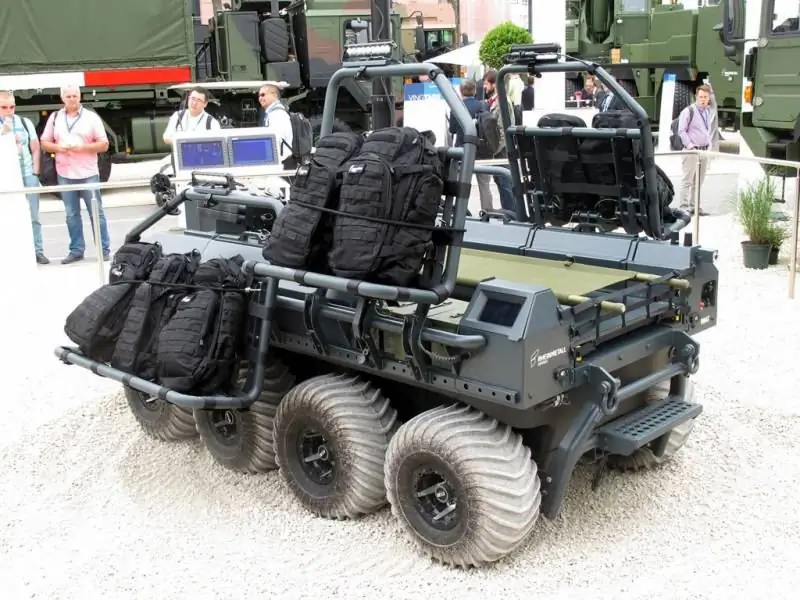
Mission Master is based on the Avenger 8x8 commercial platform developed by the Canadian company Argo. It was originally powered by a diesel engine, but Rheinmetall Canada replaced it with an electric motor and a set of lithium-ion batteries that provide approximately 8 hours of continuous operation. To make the DUM as autonomous as possible was the first goal of the company, and for this most of the "brains" of the system were installed on board; however, remote control is also possible. The Mission Master platform has a touchscreen on the rear left of the platform, which can be removed and operated from a distance of up to 100 meters. “The front sensor kit includes a 3D laser locator and TV camera, and the rear sensor unit includes a camera and a laser locator, the latter is XY,” explained Alain Tremblay of Rheinmetall Canada, adding that “two optional side cameras can be installed if the customer wishes for a circular overview". In order to increase the viewing distance and improve the quality of recognition, a radar station can also be installed on the car.
All of these subsystems can be easily installed thanks to the CAN bus, which provides automatic configuration of the connected components. The Mission Master robot with its two satellite receivers and an inertial navigation platform is capable of using any existing satellite constellation. An inertial navigation system plus a digital map of the work area loaded into the navigation system allows the Mission Master robot to navigate for a while in the absence of a satellite signal. Semi-autonomous functions such as follow me allow you to work with multiple devices.
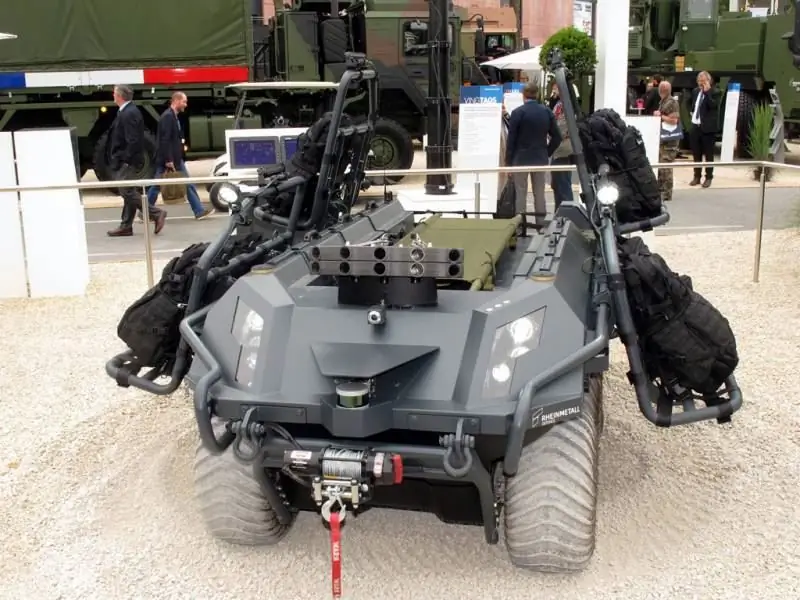
Rheinmetall Canada not only worked on autonomous modules, but also sought to adapt the platform to military missions. “We have added 16 containers along the sides of the vehicle that are compatible with NATO standard ammunition boxes, which can also be used for other purposes. Tubular racks installed on the sides allow backpacks to be folded on them, and when they are lowered, they become seats on which, for example, seated wounded can be accommodated; one stretcher can be installed on the platform, since the apparatus is 2.95 meters long,”Tremblay said. With a dead weight of less than 800 kg, the platform can take a load weighing almost 600 kg, the maximum carrying capacity in amphibious operations is 400 kg.
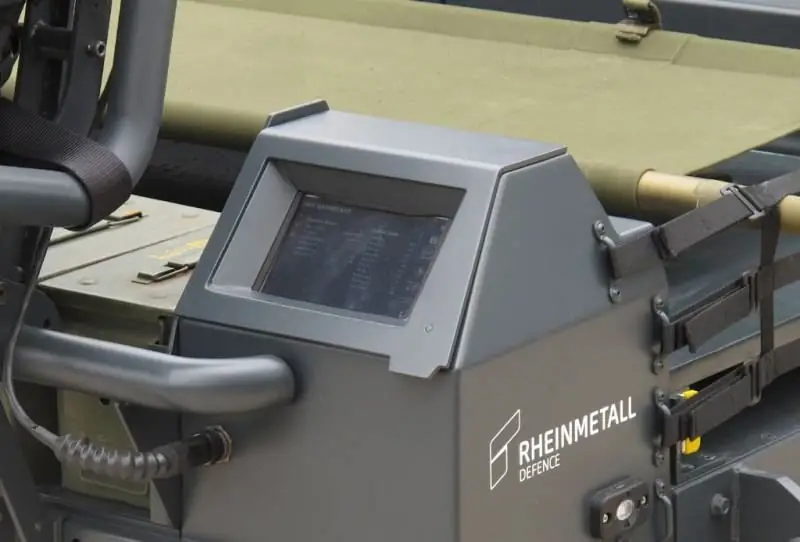
In addition to the cargo configuration, the DUM Mission Master can be equipped for other types of tasks; at an exhibition in Paris, for example, the car was shown with a DUMV armed with a 12.7 mm machine gun. Rheinmetall Canada, a member of the Rheinmetall group, develops and manufactures DUMV, but thanks to the open architecture of the system, any other combat module can be installed. Given the Mission Master's weight category, Rheinmetall Canada intends to test it with a 20mm cannon in early 2019. A different target load can be installed on the vehicle, for example, reconnaissance, relay, WMD reconnaissance or electronic warfare modules. For modules with high power consumption, an auxiliary power unit can be installed; ultimately, it can be used to extend the uptime of the platform. APU of this type, together with fuel, weighs about 10 percent of the Mission Master's carrying capacity in amphibious operations.
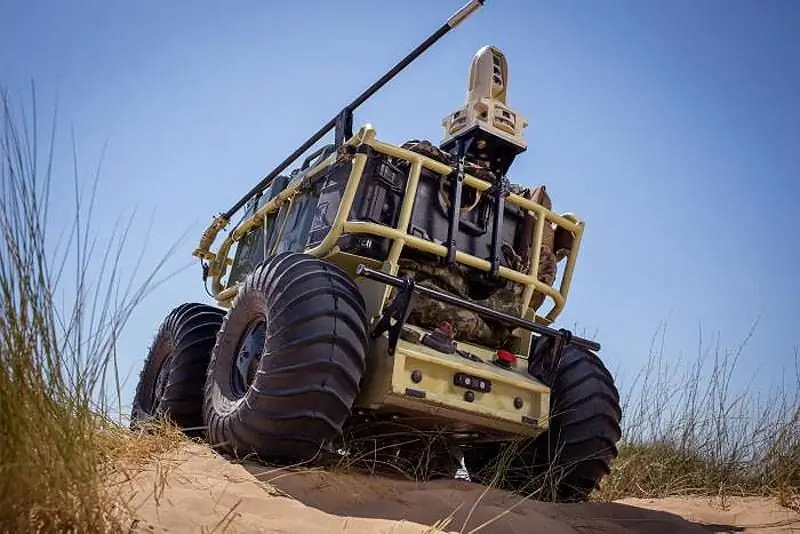
Probot from Israel and ALMRS from Britain
Limited human resources have always forced Israel to think outside the box, making this country a leader in the use of UAVs for several decades. As for unmanned ground systems, ground robots have been patrolling the borders of Ben Gurion Airport in Tel Aviv for several years. Roboteam has developed a reinforced version of the Probot 2 4x4 configuration weighing 410 kg, which, after “changing shoes” into tracks, can carry a load of 700 kg. which is much more than its own mass. The 8-hour runtime was increased by the addition of a generator that recharges the batteries while on the move, and also extends the observation mode to 72 hours - this is a requirement of the US Army's SMET program, in which Probot passed the first selection. The Roboteam DUM can reach a speed of 9.6 km / h and work on intermediate GPS coordinates or be equipped with a follow me kit.
Many European armies are looking at SDM with interest in order to reduce risks and burden on soldiers; most of them are currently interested in transportation tasks. Here we can call the British program ALMRS (Autonomous Last Mile Resupply System - autonomous supply system at the last mile), in which the calculation is made not only for ground vehicles. The document, released in June 2017, addresses three main technology areas: unmanned aerial and ground cargo platforms, technologies and systems that enable these cargo platforms to operate autonomously, and, finally, technologies for self-forecasting, planning, tracking and optimizing the supply of military users. In July 2018, five teams were selected, marking the beginning of the year-long Phase 2, in which the Army Warfighting Experiment was conducted in November of the same year.
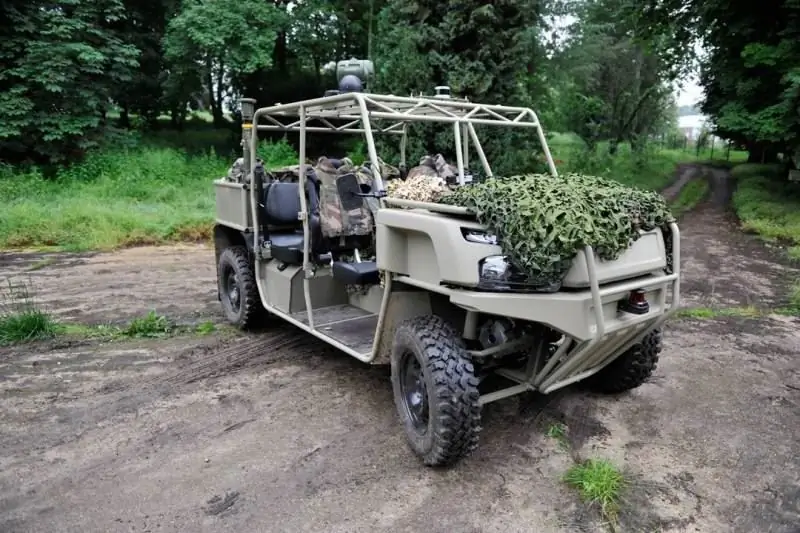
French and Italian efforts
The French Office of Land Armaments has launched the FURIOUS program (Future systemes Robotiques Innovants en tant qu'OUtilS au profit du combattant embarque et debarque - promising innovative robotic systems for the army). Its goal is to deploy three demo units of different sizes to be deployed in infantry squads at the CENZUB urban combat training center in Sisson. The task of developing these prototypes was entrusted to the company Safran Electronics & Defense and Effidence, which specializes in the use of robots in the logistics sector. In October 2017, Safran showed off the e-Rider, a hybrid diesel-electric vehicle, which was equipped with a generator, which increased the range to 200-300 km. It demonstrated its autonomous capabilities by moving fully autonomously along a pre-planned route, avoiding obstacles and returning to the starting position; the follow me mode was also shown. Safran has integrated sensors and controls into a Technical Studio 4x4 manned vehicle capable of carrying up to four passengers or one stretcher. Building on this experience, Safran will work with Effidence to develop the three demo samples required.
In early 2010, the Italian army was ready to deploy a 100 kg armed robot in Afghanistan, its main task was to ensure the security of the military base. The TRP-2 FOB, developed by Oto Melara (currently Leonardo), could reach a speed of 15 km / h, the duration was 4 hours, it was armed with a 5, 56 mm FN Minimi machine gun and a 40 mm single-shot grenade launcher. Purchased on an urgent request, the system was never deployed as it became difficult to get certified. The Italian Armaments Directorate is currently finalizing the certification process, which will alleviate the problems of handling armed SAM.

Ingegneria dei Sistemi (IDS) offers the Bulldog robotic platform. The modular DUM, presented at the Eurosatory exhibition, can be used for various tasks: transporting the wounded, neutralizing IEDs, reconnaissance and observation, or fire support. Each wheel is driven by a high-powered brushless electric motor for superior acceleration and a top speed of 40 km / h. The Bulldog has a length of 0.88 meters, a width of 0.85 meters, a dead weight of 100 kg and a load capacity of 150 kg. The latter can be significantly increased, since the electric motors allow Bulldog to tow a trailer with 300 kg, that is, the total carrying capacity is sufficient for the tasks of supplying and evacuating the wounded. The system can be quickly reconfigured from wheels to tracks. An antenna is attached to the tubular frame, providing a maximum control radius, and, if necessary, a backpack can be attached to the frame. The lithium polymer batteries are installed in two interchangeable drawers and have a typical runtime of 12 hours. Bulldog can be controlled by cable, remotely by radio, can operate in semi-autonomous mode by means of voice commands, as well as in automatic mode; a stand-alone module is available to reduce operator workload, allowing him to concentrate on the payload. The control interface is a rugged tablet with a 7-inch touch screen and joystick. The DUM is equipped with two sets of day / night sensors installed in front and behind. DUM Bulldog is currently undergoing evaluation at the Italian Army Infantry School; IDS also offers it to foreign customers.
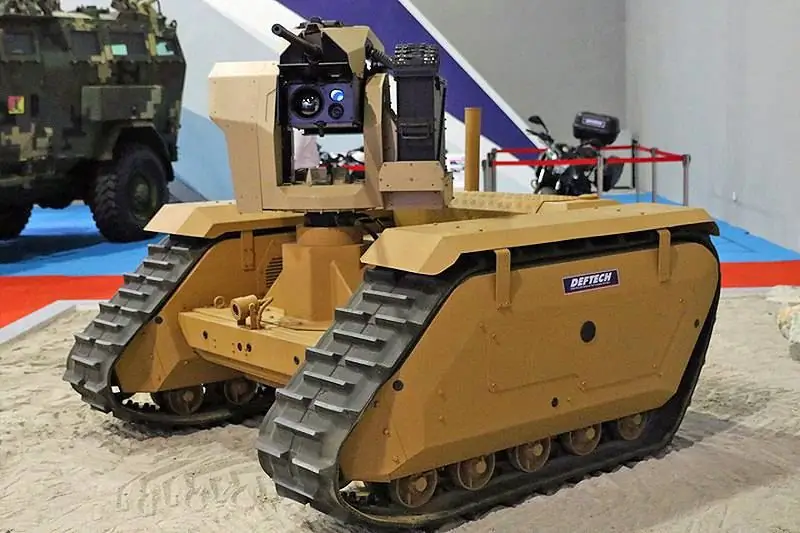
Turkish and Ukrainian achievements
The Turkish company Katmerciler has developed a heavy DUM UKAP with a dead weight of 1.1 tons and a payload of 2 tons; an electrically driven car can reach a speed of 25 km / h and run for one hour on batteries and five hours on an on-board generator. UKAP is offered with Aselsan's DUM B SARP, which can accept a 12.7mm machine gun or 40mm automatic grenade launcher. DUMV is also equipped with an automatic target tracking system that allows you to fire on the move.
Ukraine has chosen a wheeled solution and offers two DUMs, Phantom and Phantom 2. The first is a 6x6 hybrid platform with a combat weight of one ton and a payload of 350 kg, it is capable of a speed of 38 km / h. DUM, 3 meters long and 1.6 meters wide, is offered in different versions: ambulance and rescue, ammunition delivery, reconnaissance and fire support. The armed version is equipped with a DUMV with a 12, 7-mm machine gun and four ATGM "Barrier" with a range of 5 km. The Phantom was reportedly tested at the end of 2017, followed by the certification process. A further development of this platform was the DUM Phantom 2 with a length of 4, 2 meters, a combat weight of 2, 1 tons and a carrying capacity of 1, 2 tons, which allows you to install more powerful heavy weapons.

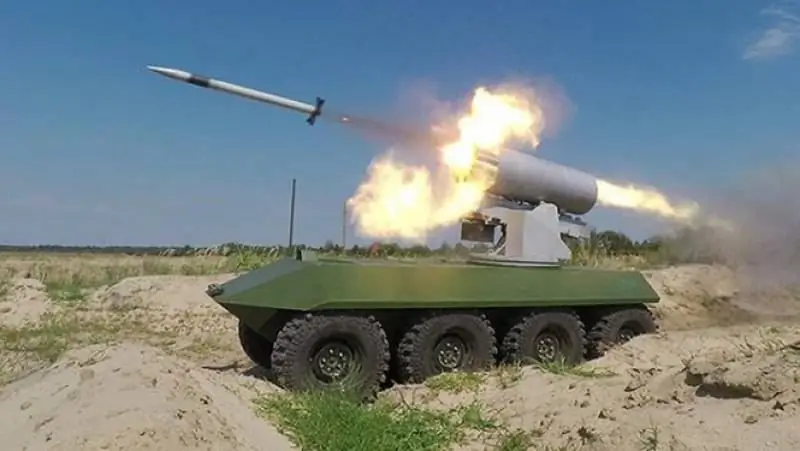
Many other systems were developed, the description of which was not included in the article, although photographs of some of them are given, for example:
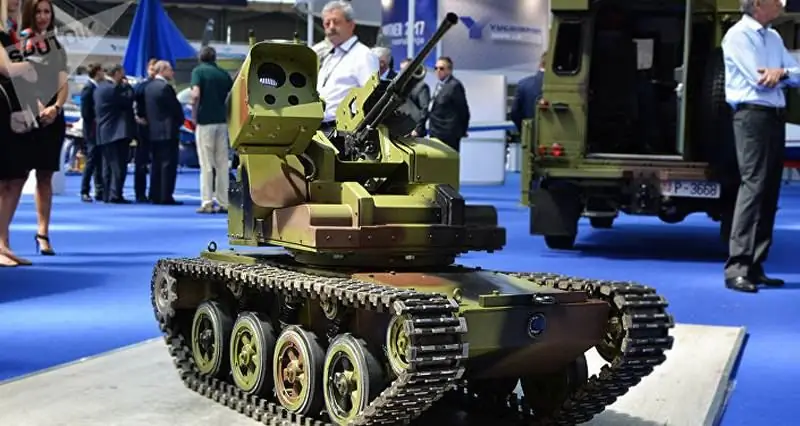
American approach
The US Army is undoubtedly interested in unmanned ground vehicles in order to increase combat effectiveness and reduce risks. In the future, various systems can be assigned to combat brigades of three types, heavy, medium and light.
For several years now, the army has been implementing the so-called Wingman Joint Capability Technology Demonstration (JCTD - Technology Capability Research Program), within which a command and control machine based on the HMMWV was developed, equipped with the LRASSS (Long Range Advanced Scout Surveillance System) target detection system. long-range reconnaissance system). The second robotic vehicle of the complex, also based on the HMMWV, is equipped with a tripod on which the Picatinny LRWS module is installed, armed with an M240B machine gun; as an option, a multi-barreled M134 Gatling machine gun can be installed. The machine is controlled by a set of sensors and electronics Robotic Technology Kernel. In mid-2018, the American army decided to expand this program to other platforms, including the M113 armored personnel carrier with the simultaneous installation of a DUMV CROWS armed with a 12.7 mm machine gun on it. The ultimate goal is to test the possibility of certification of the system at the Scout Gunnery Table VI, where the certification of the crews of combat vehicles takes place.
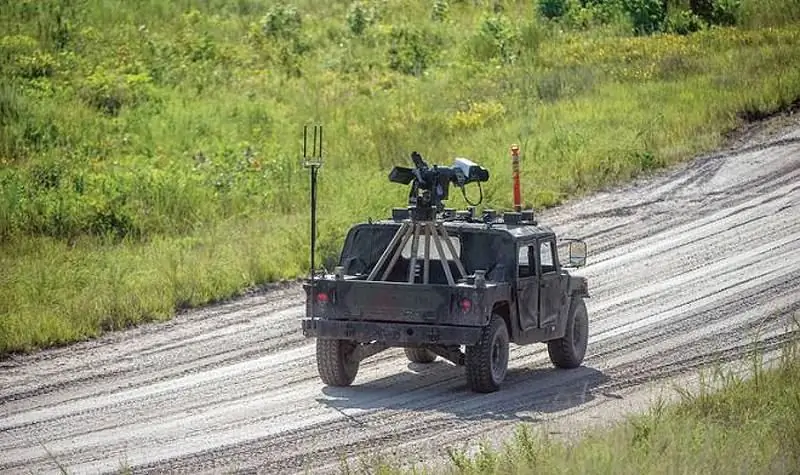
With regard to logistics support, more progress is seen here. The refinement of the SMET (Squad-Multipurpose Equipment Transport) program for a multi-purpose squad-level equipment transportation platform is ongoing, but the current goal is to develop a land-based robotic complex capable of performing logistics tasks in order to reduce physical stress on light dismounted forces. The US Army in December 2017 selected four participants for the SMET project: Applied Research Associates (ARA) and Polaris Defense (Team Polaris); General Dynamics Land Systems (GDLS); HDT Global; and Howe & Howe Technologies.
The original principles of combat use and SMET requirements related to a vehicle that could accompany soldiers walking at a speed of 3 km / h for up to 72 hours without refueling over a distance of 97 km. Ultimately, the device will have to work in three modes: autonomous, semi-autonomous and remote control.
The platform must carry a load of 454 kg and generate 3 kW when parked and 1 kW in motion. Transporting 454 kg will reduce the load on each soldier in the squad by 45 kg. By reducing the load, the platform will allow Infantry Brigade Combat Team (IBCT) infantry brigade groups to travel long distances, while the generation of electricity from this platform will allow recharging equipment and batteries on the go. The Marine Corps also has similar needs, but who will choose is still unclear.
The Army also wants to reduce the burden on its supply chain, which has awarded Oshkosh Defense a $ 49 million contract to integrate autonomous technology into its Palletized Load System, a multi-functional transport platform. Called Expedient Leader Follower, this program will allow unmanned trucks to become part of convoys.






